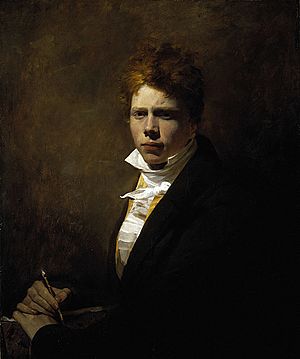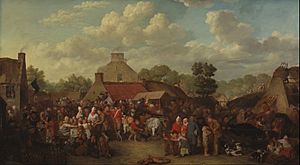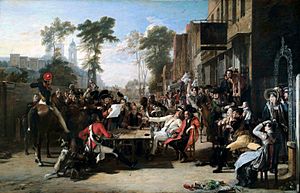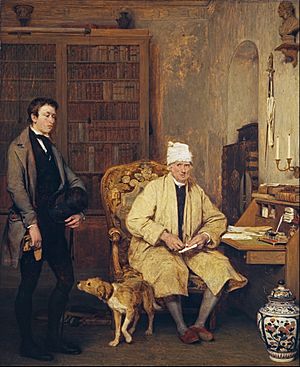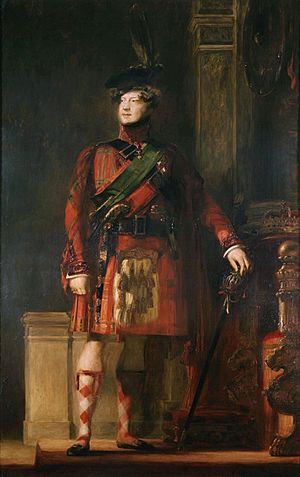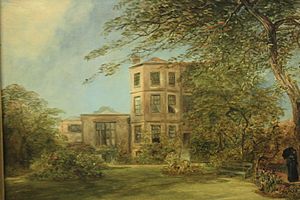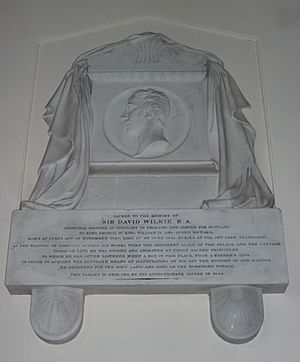David Wilkie (artist) facts for kids
Sir David Wilkie (born November 18, 1785 – died June 1, 1841) was a famous Scottish painter. He was especially known for his paintings of everyday life, called genre scenes. He also painted many other types of art, including historical events, portraits of people (even kings and queens!), and scenes from his travels.
Wilkie mostly lived in London. Sadly, he died and was buried at sea near Gibraltar. This happened when he was returning from his first trip to the Middle East. People sometimes called him the "people's painter" because his art often showed ordinary people.
He was the official painter to King William IV and Queen Victoria. One of his most famous paintings today is The Chelsea Pensioners reading the Waterloo Dispatch from 1822. You can see it at Apsley House in London.
Contents
Early Life and Art
David Wilkie was born in Pitlessie, Fife, Scotland, on November 18, 1785. His father was a minister in the church. David loved art from a young age.
In 1799, after finishing school, his father finally agreed to let him become a painter. Wilkie was accepted into the Trustees' Academy in Edinburgh. There, he studied art under John Graham.
His friends from art school, William Allan and John Burnet, said that Wilkie was very determined. He loved to visit fairs and markets. He would sketch interesting people and events he saw there. He admired other Scottish painters who showed scenes from everyday life.
One of his early important paintings was Pitlessie Fair (1804). It shows about 140 people, including his neighbors and family. In 1805, Wilkie moved from Scotland to London. He sold one of his first paintings, Bounty-Money, or the Village Recruit, for £6. He then began studying at the Royal Academy.
His painting The Village Politicians became very popular when it was shown in 1806. The next year, he painted The Blind Fiddler. This painting was ordered by his good friend, Sir George Beaumont.
Painting Historical Scenes
Wilkie then started painting historical scenes. One of these was Alfred in the Neatherd's Cottage. After this, he went back to painting everyday life. He created The Card-Players and The Rent Day.
His next big work was The Ale-House Door, later called The Village Festival. This painting was bought for 800 guineas. In 1813, he painted Blind Man's Buff for the the Prince Regent. He also painted The Penny Wedding in 1818.
Honours and Recognition
In November 1809, Wilkie became an associate of the Royal Academy. This was even though he was younger than the usual age limit. In February 1811, he became a full member of the Academy. In 1812, he held an exhibition of his paintings in Pall Mall. However, he didn't make much money from it.
Travels and New Styles
In 1814, Wilkie painted The Letter of Introduction. It is one of his most detailed and perfect small paintings. That same year, he visited Europe for the first time. In Paris, he loved studying the artworks at the Louvre museum.
When he returned, he started Distraining for Rent, a very popular and dramatic painting. In 1816, he traveled through the Netherlands and Belgium. Reading the Will was finished in 1820. Two years later, his famous painting The Chelsea Pensioners reading the Waterloo Dispatch was shown. The Duke of Wellington had ordered this painting in 1816.
In 1817, Wilkie returned to Scotland. He painted Sir Walter Scott and his Family (also called The Abbotsford Family). This painting showed the famous writer Sir Walter Scott and his family dressed as Scottish peasants.
Painting for the King
In 1822, Wilkie visited Edinburgh to find a good subject for a painting about King George IV's visit to Scotland. He chose to paint "The Reception of the King at the Entrance of Holyrood Palace." The next year, Wilkie became the official Royal Limner for Scotland. He met the King and started working on the painting.
This painting took several years to finish. It was a difficult job for him and made him stressed. His health suffered, and he also had personal problems at home.
More Foreign Travels
In 1825, Wilkie traveled abroad to feel better. He visited Paris, then went to Italy. In Rome, he heard bad news about his publishers losing money. He tried staying in Toplitz and Carlsbad in 1826, but it didn't help much. Then he went back to Italy, visiting Venice and Florence.
In the summer of 1827, he stayed in Geneva. He felt well enough to paint Princess Doria Washing the Pilgrims' Feet. This work, like other small paintings he did in Rome, was influenced by the Italian art around him. In October, he went to Spain, returning to Britain in June 1828.
These three years of travel greatly changed Wilkie's art style. Before his travels, he was mainly influenced by Dutch painters. He studied their techniques and often kept their works in his studio. He used their methods to paint scenes of English and Scottish life. But after his travels, he was inspired by Italian masters and Spanish painters like Diego Velázquez.
Later Years and Final Journey

In his later works, Wilkie's style changed. He used broader brushstrokes, richer colours, and larger effects. His subjects also changed from everyday life to historical scenes, often inspired by his travels. Some people criticized this change. They missed his earlier, more detailed paintings. While his later works sometimes had drawing flaws, some of them showed great skill with colour.
Many of Wilkie's paintings from his foreign travels, like The Pifferari and Princess Doria, became part of the English royal collection. His painting Preaching of John Knox before the Lords of the Congregation was one of his most successful later works.
In 1830, Wilkie became the official painter to the king, taking over from Sir Thomas Lawrence. In 1836, he was made a knight. Some of his main paintings from this period include Columbus in the Convent at La Rabida (1835) and Queen Victoria Presiding at her First Council (1838). He also painted many portraits, including for the royal family.
In the autumn of 1840, Wilkie decided to travel to the East. He went through the Netherlands and Germany to Constantinople. There, he painted a portrait of the young sultan. He then sailed to Smyrna and traveled to Jerusalem, where he stayed for five busy weeks. His very last work was a portrait of Muhammad Ali Pasha in Alexandria.
On his way back to Britain, he became ill near Malta. He remained sick for the rest of the journey. Sir David Wilkie died at sea off Gibraltar on the morning of June 1, 1841. His body was buried at sea in the Bay of Gibraltar. The artist Joseph Mallord William Turner created a famous painting called Peace – Burial at Sea to remember Wilkie's death.
Achievements and Legacy
A detailed book about Sir David Wilkie, including his journals, was published in 1843 by Allan Cunningham. Wilkie was also a skilled etcher. His best etchings are considered as good as those by other great artists. In 1875, David Laing cataloged and published all of Wilkie's etchings.
Wilkie was the godfather to the son of his artist friend, William Collins. The boy was named Wilkie Collins and later became a famous novelist.
See also
 In Spanish: David Wilkie para niños
In Spanish: David Wilkie para niños
- List of Orientalist artists
- Orientalism


